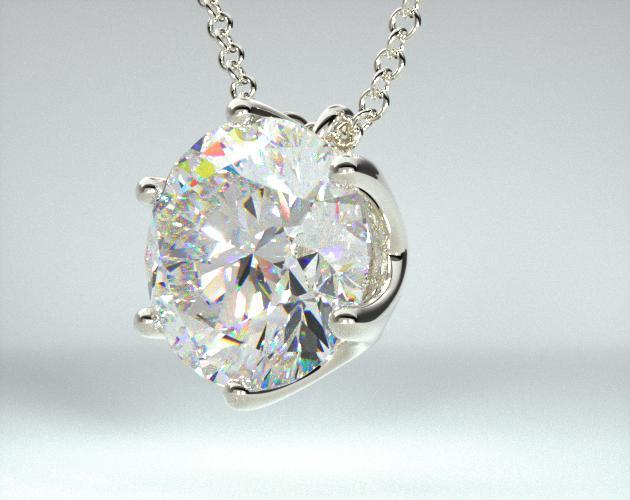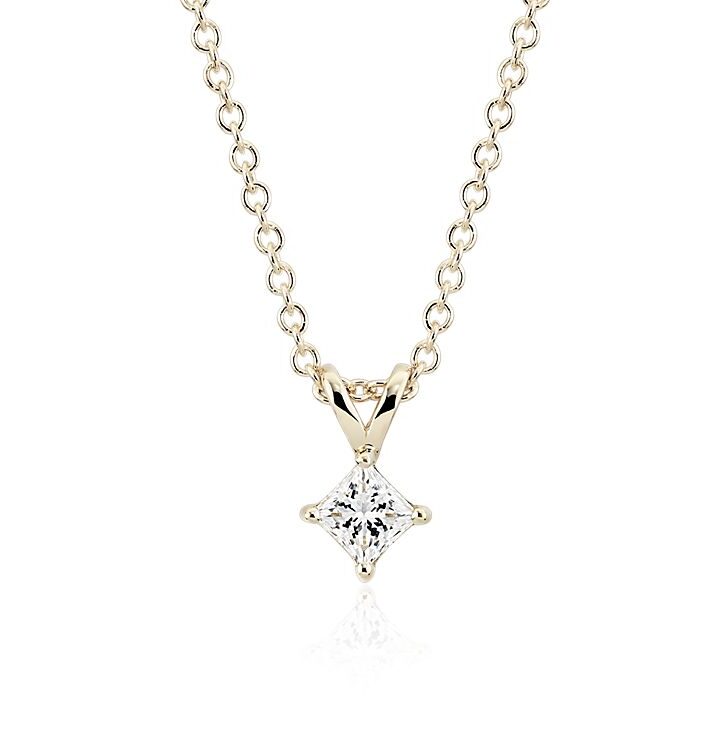
Table of Contents
As Jewelry Shopping Guide editors, we write about things that we love and we think you’ll like too. We often have affiliate partnerships, and may generate some revenue from these links at no cost to you.
A diamond pendant is an excellent addition to any jewelry collection. It’s versatile, and classic, and goes with any outfit be it night or day. Just like a diamond solitaire ring or diamond stud earrings, diamond pendants too can be worn daily for effortless chic. Diamond pendants also make excellent gifts that will be treasured and worn for decades.
There are many types and styles of diamond pendants so it’s important to choose carefully to make sure you buy the right one for you and your style.
It’s also important that you purchase from a reputable vendor. After all, it’s a valuable purchase and you want to get it right.
Let’s take a look at how to buy the perfect diamond pendant for your money’s worth.
Diamond Pendant Styles
There are many diamond pendant styles available, so it’s important to have an idea of what sort of style you’re after. Are you looking for a classic everyday style or something a little dressier?

The most popular and versatile style is the diamond solitaire pendant. This consists of a single diamond worn at the end of a chain. The diamond solitaire pendant style is simple and classic, ideal for wearing on a regular basis. You can dress it up or down and it’ll still look stylish, going beautifully with jeans and a t-shirt or a stylish evening gown.
These pendants come mounted in different settings which also influence the overall style of the pendant, so pay attention to the setting style as well (more on this below).

For pendants that are more eye-catching, consider multiple stones, halos, and different shapes. Pendants with lots of melee diamonds will be more sparkling and brilliant but may not be as valuable as a single solitaire.
Browse through different collections and get a feel of the various styles on offer.
Diamond Pendant Settings
Diamond pendants generally come in gold and platinum settings, which don’t tarnish and can be worn daily.
Platinum is the most prestigious of the jewelry metals and is considerably more expensive than gold. Gold comes in three colors – white, yellow, and rose –, with two purity levels (14K and 18K) and is a more budget-friendly choice.
In terms of settings, diamond pendants are commonly mounted in prong settings, usually with 4 or 6 prongs holding the diamond in place.
The advantage of prong settings is that it has minimal interference with the diamond’s light performance, allowing the stone to interact with light from all angles. This enhances the brilliance and fire of the diamond and makes the stone sparkle beautifully.
Another popular setting is the bezel setting like this white gold bezel set diamond pendant. Bezel settings surround the entire diamond in metal, keeping it safe and secure in its mounting. However, this can minimize the sparkle of the diamond as you only see the stone from the face-up.

The halo setting adds a sparkling rim of diamond melees around the center stone, enhancing brilliance while keeping the diamond safe as well.
When considering the setting for your diamond pendant, note that while it should hold the diamond securely, the durability of the setting isn’t as big a consideration as it is for a diamond ring. Unlike a ring, a pendant is less exposed to wear and tear.
Check out more diamond pendants here.
What Diamond Shape to Choose

The quintessential shape for diamond pendants is the round brilliant. However, you’ll also find many square-shaped diamond pendants available. These two are the most popular diamond shapes, especially for pre-made jewelry.
However, there are many other diamond shapes to choose from if you want a unique-looking pendant.

Some sites like Blue Nile and James Allen have to design your own pendant tools which allow you to choose your diamond, setting, and chain length to customize the pendant exactly as you wish.
How to Choose the Diamond for Your Pendant

Not all diamonds are created equal and the diamond you choose will depend on how much you are willing to spend on it. When picking out your diamond, you should keep the 4Cs in mind.
1. Diamond Cut
Cut is the most important of the 4Cs when it comes to colorless diamonds. An expertly cut diamond will have enhanced brilliance and fire resulting in beautiful sparkle. On the other hand, a poorly cut stone will look lifeless and dull.
If budget is not a concern, an Excellent or Ideal cut stone is best as these have been cut to exact proportions. Examine the diamond closely, from all angles, and see how it interacts with light. Make sure you see the actual diamond and not some stock image. This is where the HD videos and images of sites like James Allen stand out with their quality.
2. Diamond Color
Look for a diamond that is colorless in relation to the setting. If the color of the setting is white gold, choose a diamond in the near-colorless range, but if it’s rose or yellow gold like this frame pendant, you can drop lower down on the scale as the stone will look colorless in relation to the metal color.
3. Diamond Clarity
Clarity grade is only important as long as it doesn’t interfere with the appearance and integrity of the stone. Just examine your stone very carefully to look for impurities or flaws that may be visible face-up.
Diamonds in pendants are more visible than those in a ring, but there’s little chance that someone is going to stick their face up against your neck to inspect your diamond, the way they would inspect your ring.
4. Diamond Carat
A one carat diamond is usually large enough to be seen without being overly flashy, but of course, this depends on your budget and preference. Remember that the larger the diamond, the more visible any defects in the stone (color, clarity). Don’t compromise quality for size.
Try sticking to diamonds that are slightly below standard sizes. You’ll find that a 1-carat stone will be more expensive than a .93 stone all else being equal. There’s hardly any noticeable difference in appearance.
5. Diamond Certification
Often called the 5th diamond C, certification allows you to buy with peace of mind knowing that your diamond has been evaluated by a reputable lab. GIA and AGS are the most trustworthy labs with high standards and diamonds graded by these labs are the best.
Choosing Your Diamond Pendant Chain

If you’re going to wear the pendant daily, pick a chain that’s strong and tough. Choose either gold or platinum as these are perfect for daily wear.
The chain length you choose depends on your choice, but for daily wear, 16 to 18 inches are the most common lengths. These fall right at the sternum and are comfortable to wear and complement most outfits.
A 14-inch chain is a choker style and can be very uncomfortable for daily wear, while longer chains (22 to 24 inches) can keep your diamond out of site and fall below your sternum.
Sites like Blue Nile allow you to pick chains based on metal, length, and type.
When to Give a Diamond Pendant Gift
Diamond pendants are a perfect gift for a loved one, whether it’s your romantic partner, a close family member, or a good friend. It’s a useful gift and one that will become a staple of their jewelry collection.
Before you buy, consider the type of jewelry that person wears. Do they like diamond jewelry (who doesn’t!) and what is their style? You don’t want to spend so much money only to buy something they want to return.
In general, though, you can’t go wrong with a diamond pendant. Just ensure you get the right chain length, size, and color.
Diamond pendants are perfect for:
- Valentine’s Day gifts
- Anniversary gifts
- Graduation gifts
- Mother’s Day gifts
- Promise Jewelry
Where to Buy Diamond Pendant
The most important thing when buying a diamond pendant is to ensure that you’re buying from a reputable vendor. Diamonds are an expensive purchase and you want to ensure that you aren’t getting ripped off.
Look for a retailer with a proven track record and high-quality products. It’s also essential that they provide information about the actual diamond you’re looking at, including videos and images.
Based on our experience in the industry, we recommend the following retailers:
1. James Allen
Currently, James Allen is the only online retailer that allows you to have a 360-degree view of a diamond pendant. Take a look at this bezel set diamond pendant and watch it spin in a complete circle, allowing you to view the details from all sides. It’s the next best thing to see the pendant in your own hands. James Allen has a range of beautiful diamond pendant settings in many styles. Their prices are competitive, and their quality is impeccable.
2. Blue Nile
Blue Nile has an impressive range of diamonds, with over 150,000 in its inventory. Their Build Your Own Pendant tool allows you to create a diamond pendant that suits your tastes. They’ve also got stunning ready-made diamond pendants in a range of styles and for a variety of budgets.
3. Brian Gavin
Brian Gavin’s diamonds are famous for their cut quality and the company is known for its continuous innovation in perfecting their cut quality. Their range of diamond pendants is stylish and expertly crafted.









